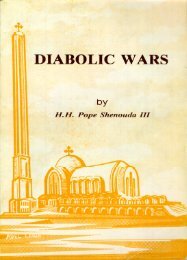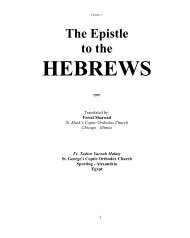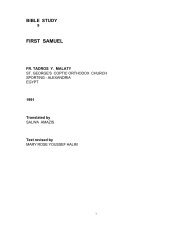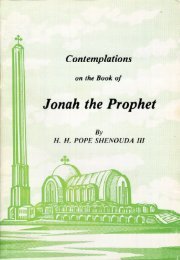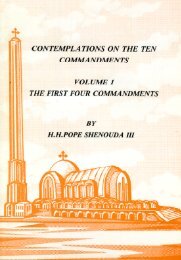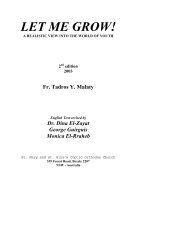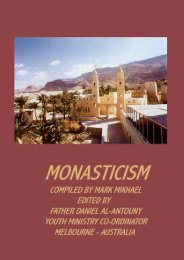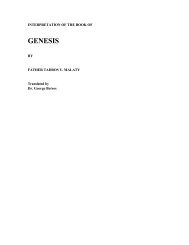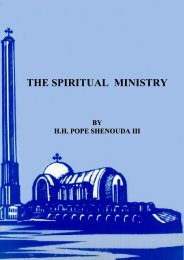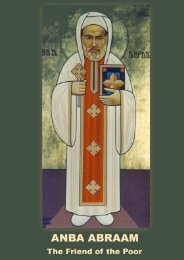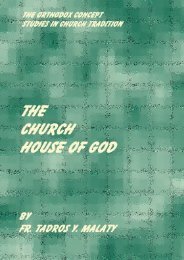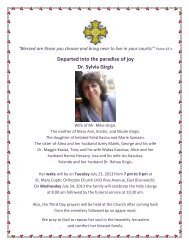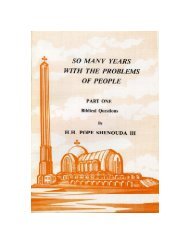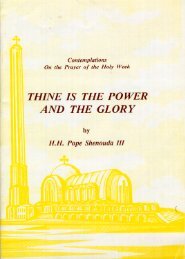The Coptic calendar and the church
The Coptic calendar and the church
The Coptic calendar and the church
You also want an ePaper? Increase the reach of your titles
YUMPU automatically turns print PDFs into web optimized ePapers that Google loves.
Our Lord <strong>and</strong> Saviour Jesus Christ King of Kings <strong>and</strong>Lord of lords2
THE BEHOLDER OF GODMARK THE EVANGELISTSAINT AND MARTYR3
H.H. Pope Shenouda III, 117th Pope ofAlex<strong>and</strong>ria <strong>and</strong> <strong>the</strong> See of St. Mark4
THE PHARAONIC CALENDER AND THECOPTIC CALENDER<strong>The</strong> Pharaohs knew <strong>the</strong>ir <strong>calendar</strong> from <strong>the</strong> year 4240B.C. <strong>The</strong> famous Greek historian Herodotus mentions that<strong>the</strong> Egyptians excelled <strong>the</strong> Greeks in adjusting <strong>the</strong>ir solaryear by appending 5 days to <strong>the</strong> total of 12 months 1 .Early Egyptian Christians used <strong>the</strong> Pharaonic systemsof reckoning time, modified <strong>the</strong>m a little bit, <strong>and</strong> adapted<strong>the</strong>m to <strong>the</strong>ir Church life <strong>and</strong> <strong>the</strong>ir daily life, especially foragricultural system. <strong>The</strong> liturgical day of Christians in Egyptbegan, <strong>the</strong>n as now, at sunset, like <strong>the</strong> Jewish, <strong>and</strong> Greekdays. <strong>The</strong> seven-day week is used, with its first day(Sunday) made <strong>the</strong> Lord’s Day.<strong>The</strong> Christian Copts still use <strong>the</strong> <strong>Coptic</strong> year, whoseorigin is Pharaonic. <strong>The</strong> year is divided into twelve monthsof thirty days each, plus five more days, called epagomenai,at its end, as well as <strong>the</strong> extra day whose intercalation at <strong>the</strong>end of every fourth year as a sixth epogomenal day wasordered by Ptolemy III Euergetes in 238 B.C., in order torectify <strong>the</strong> old discrepancy between <strong>the</strong> <strong>calendar</strong> year of 365days <strong>and</strong> <strong>the</strong> natural solar year.<strong>The</strong> year was divided into three seasons of equallength, each comprising four months, <strong>the</strong> season of <strong>the</strong> flood,<strong>the</strong>n that of cultivation, <strong>and</strong> thirdly <strong>the</strong> season of <strong>the</strong> harvest<strong>and</strong> fruits. This division is still used in <strong>the</strong> liturgical rites of<strong>the</strong> <strong>church</strong> in Egypt <strong>and</strong> overseas, until a synodical creed was1 Herodotus, 2:4.5
issued for collecting <strong>the</strong> three litanies of water, fruits, <strong>and</strong>wea<strong>the</strong>r in one litany for overseas, as <strong>the</strong> circumstances <strong>the</strong>rediffers than that in Egypt.THE PHARAONIC CALENDER AND THEJULIAN CALENDER<strong>The</strong> Roman adaptation of <strong>the</strong> Egyptian solar <strong>calendar</strong>introduced by Julius Caesar, with <strong>the</strong> technical aid of <strong>the</strong>Alex<strong>and</strong>rian astronomer Sosigenes, in 46 B.C.THE “ABAKTI” AND THE CHRISTIANPASCH THE COPTIC CALENDERSince <strong>the</strong> fourth century, as many of <strong>the</strong> Copts weremartyred, <strong>the</strong>y considered <strong>the</strong> Era of Diocletian as <strong>the</strong> goldenage, <strong>and</strong> chose <strong>the</strong> year of Diocletians’s military election asemperor in November 284 as <strong>the</strong> starting point of <strong>the</strong>ir<strong>calendar</strong>. <strong>The</strong> Era of Diocletian is usually called <strong>the</strong> “Era of<strong>the</strong> Martyrs,” <strong>and</strong> its abbreviation is A.M. (for annomartyrdum).We can underst<strong>and</strong> why <strong>the</strong> Copts are interested inthus era from <strong>the</strong> writing one of <strong>the</strong> fa<strong>the</strong>rs of <strong>the</strong> Churchwho was contemporary of <strong>the</strong> reign of Diocletian: “If <strong>the</strong>martyrs of <strong>the</strong> whole world were put on one arm of <strong>the</strong>balance <strong>and</strong> <strong>the</strong> martyrs of Egypt on <strong>the</strong> o<strong>the</strong>r, <strong>the</strong> balancewould tilt in favor of Egyptians.”6
THE COPTIC MONTHSAlthough <strong>the</strong> exigencies of modern life haveled toextensive use of <strong>the</strong> Gregorian <strong>calendar</strong> <strong>and</strong> of <strong>the</strong> Islamic<strong>calendar</strong> with Years reckoned from <strong>the</strong> Hegira, <strong>the</strong> <strong>Coptic</strong><strong>church</strong> also continues to observe Alex<strong>and</strong>rian yearsbeginning on <strong>the</strong> Julian 29 August in an ordinary year, <strong>and</strong> toreckon <strong>the</strong> succession of years according to <strong>the</strong> Era ofDiocletian or “of <strong>the</strong> Martyrs.” For twelve months of thirtydays, <strong>the</strong> ancient Egyptian names introduced in <strong>the</strong> first halfof <strong>the</strong> first millenium B.C. are retained, in forms that arecopticized or arabized. In <strong>the</strong> Bohairic dialect, <strong>the</strong>epagomenal period added at <strong>the</strong> end of <strong>the</strong> year is called “<strong>the</strong>little month.” In Arabic <strong>the</strong> same period is called al-Nasi,“<strong>the</strong> extension (of time)” or “postponement.”To convert a <strong>Coptic</strong> or Ethiopian date (day <strong>and</strong>month) to its Julian equivalent in an ordinary year (a year A.M.of Ethiopian not divisible by 4), add <strong>the</strong> numeral of <strong>the</strong><strong>Coptic</strong> or Ethiopian month in question (which can be foundin <strong>the</strong> accompanying table). For instance, to find <strong>the</strong> Juli<strong>and</strong>ate corresponding to <strong>the</strong> <strong>Coptic</strong> 15 Kiyahk in an ordinaryyear, add 15 ( <strong>the</strong> numeral of <strong>the</strong> day of Kiyahk) to 26November ( <strong>the</strong> day before <strong>the</strong> beginning of <strong>the</strong> Julian periodcorresponding to <strong>the</strong> month of Kiyahk in an ordinary year).Thus, 15 plus 26 November becomes 41 November, that is,11 December.To convert a year A.M. to <strong>the</strong> corresponding year(s)A.D. add 283 to <strong>the</strong> year A.M. from 1 Tut through 31December: add 284 to <strong>the</strong> year A.M. from 1 January to <strong>the</strong>end of <strong>the</strong> <strong>Coptic</strong> year. Thus, A.M.1700 equals A.D.1983/1984.7
THE JULIAN CALENDAR<strong>The</strong> Julian year was extended to 445 days byintercalation in order to bring <strong>the</strong> civic year into line with <strong>the</strong>solar year. While <strong>the</strong> Egyptians divided <strong>the</strong> solar year of365.25 days into 12 months of 30 days each, with 5, or inevery fourth year, 6, intercalary days added after <strong>the</strong> last dayof <strong>the</strong> twelfth month, <strong>the</strong> Romans, in <strong>the</strong>ir Julian <strong>calendar</strong>,retained <strong>the</strong> 31 days of March, May, Quintilis (July), <strong>and</strong>October, <strong>and</strong> <strong>the</strong> 28 days of February, as <strong>the</strong>y had been in<strong>the</strong> older Roman <strong>calendar</strong>, but increased <strong>the</strong> o<strong>the</strong>r months,which until <strong>the</strong>n all had 29 days, by one day (June, April,September, November) or two days (January, Sextilis[August], December), in order to have an annual total of 365days. <strong>The</strong> intercalary month previously inserted periodically,at <strong>the</strong> discretion of pontifex maximus, after 23 February wasreplaced by <strong>the</strong> intercalary day inserted every fourth yearafter 23 February, <strong>and</strong> in such a year <strong>the</strong> 24 February (antediem sextum Kalendas Martias) was counted twice, <strong>the</strong>intercalary day being ante diem his sextum Kalendas Martias,hence <strong>the</strong> expression annus bissextilus for “leap year.” In <strong>the</strong>first thirty-six years of <strong>the</strong> Julian <strong>calendar</strong>’s use, <strong>the</strong> extra daywas intercalated every three years instead of every four, bymistaden interpretation of <strong>the</strong> original prescription, <strong>and</strong> in 9B.C.Augustus prohibited <strong>the</strong> inntercalation of <strong>the</strong> extra dayuntil A.D. 8. <strong>The</strong> vernal equinox was placed on 25 March,<strong>and</strong> <strong>the</strong> year began on 1 January.<strong>The</strong> Julian <strong>calendar</strong> remained in general use in <strong>the</strong>Western world until it was replaced by <strong>the</strong> Gregorian<strong>calendar</strong>, itself a reform of <strong>the</strong> Julian <strong>calendar</strong>, in variouscountries between 1582 <strong>and</strong> 1924. It is still used for <strong>the</strong>calculation of Easter <strong>and</strong> <strong>the</strong> movable feasts dependent onEaster in <strong>the</strong> Chalcedonian Orthodox <strong>church</strong>es.8
MONTHS OF THE COPTIC CALENDAR,Of all survivals from Pharaonic Egypt, <strong>the</strong> <strong>calendar</strong> is<strong>the</strong> most striking. Each of <strong>the</strong> twelve months of <strong>the</strong> <strong>Coptic</strong><strong>calendar</strong> still carries <strong>the</strong> name of one of <strong>the</strong> deities of feastsof ancient Egypt. Without doubt, this reflects <strong>the</strong>conservatism that characterizes <strong>the</strong> inhabitants of <strong>the</strong> NileValley, who are reluctant to set aside <strong>the</strong>ir traditional way oflife.Documents from around <strong>the</strong> fifth century B.C., such as<strong>the</strong> Aramaic papyri from Elephantine, indicate that <strong>the</strong> greatfestivals held in honor of certain divinities gave <strong>the</strong>ir namesto <strong>the</strong> month in which that particular celebration occurred.<strong>The</strong> Copts did not change <strong>the</strong> names of <strong>the</strong> Pharaonicmonths:Tut: (September 11-12 to October 10-11). It wasdedicated to Thoth, god of wisdom <strong>and</strong> science, inventor ofwriting , patron of scribes, <strong>and</strong> “he who designates <strong>the</strong>seasons, months, <strong>and</strong> years.” Thoth presided over <strong>the</strong>“House of Life,” where were composed <strong>and</strong> copied all textsnecessary for <strong>the</strong> maintenance <strong>and</strong> replenishment of life.Babah: (October 11-12 to November 9-10). During<strong>the</strong> second month was celebrated <strong>the</strong> “ Beautiful feast ofOpet.’’ whose name Paopi signifies “that of Opet.” We seeAmon-Ra traveling from Karnak to Luxor to celebrate <strong>the</strong>famous festival of Opet, from which <strong>the</strong> month Babahderives its name.”Hatur: (November 10-11 to December 9-10). Itcommemorated Hathor, <strong>the</strong> “Cow of Heaven,” who gavebirth to <strong>the</strong> sun <strong>and</strong> to all beings, gods, <strong>and</strong> men.9
Kiahk: (December 10-11 to January 8-9). Thismonth derives its name from a ritual vase that was probablyused for meauring incense <strong>and</strong> was very important in <strong>the</strong>celebration of <strong>the</strong> funerary feast originally known as <strong>the</strong>Union of <strong>the</strong> Ka.Tubah: (January 9-10 to February 7).Amshir: (February 8-9 to March 9-10). It is relatedto fire <strong>and</strong> represented in <strong>the</strong> lists of festival objects by abrasier from which fire escapes.Baramhat: (March 10 to April 8).Baramudah: (April 9-10 to May 8).Bashans: (May 9 to 7 June).Baounah: (June 8 to 7 July).Abib: (July 8 to 6 August).Misra: (August 7 to 5 September).Nasi: (6 September to 10-11 September).10
Front coverAn elaborate painting of <strong>the</strong> cross, from Abu Seifain Church, Old Cairo.
Fa<strong>the</strong>r Matta El-MeskeenSpiritual Fa<strong>the</strong>r of <strong>the</strong> Monastery of St. Macarius<strong>Coptic</strong> Calendar<strong>The</strong> Origin of <strong>the</strong> Calendarof <strong>the</strong> <strong>Coptic</strong> ChurchTHE MONASTERY OF ST. MACARIUS1988
Fa<strong>the</strong>r Manta El-MeskrenTHE ORIGIN OF THE COPTIC CALENDARTHE pharaonic Egyptians were <strong>the</strong> first in <strong>the</strong> world whomeasured time, who dated <strong>the</strong> years, <strong>and</strong> who divided <strong>the</strong>years into months. For <strong>the</strong>ir record keeping, <strong>the</strong>y used a solar<strong>calendar</strong>. <strong>The</strong>y knew that <strong>the</strong> year was approximately 365 dayslong, <strong>and</strong> <strong>the</strong>y organized <strong>the</strong>ir <strong>calendar</strong> with precision, dividingit into months with 30 days alloted to each-<strong>and</strong> all this in <strong>the</strong>year 4240 B.C. In his writings on Egypt, <strong>the</strong> famous Greekhistorian Herodotus says that <strong>the</strong> Egyptians were led to thisconclusion by means of <strong>the</strong> stars, <strong>and</strong> that <strong>the</strong>y greatly excelled<strong>the</strong> Greeks in adjusting <strong>the</strong>ir solar year so that it should beginexactly on schedule. This <strong>the</strong>y accomplished by appending anextra 5 days to <strong>the</strong> total of 12 months; <strong>the</strong>se 5 days <strong>the</strong>y called <strong>the</strong>“small month.“At this point it is worth drawing <strong>the</strong> reader’s attention to <strong>the</strong>fact that it is this solar <strong>calendar</strong> of <strong>the</strong>ancient Egyptians, based onsidereal calculations (i.e., by means of <strong>the</strong> stars), that has beenadopted by all <strong>the</strong> rest of <strong>the</strong> world.Herodotus. 2:4.
4It is well known that <strong>the</strong> <strong>Coptic</strong> solar year used to be dividedinto three seasons ra<strong>the</strong>r than four as is currently <strong>the</strong> case.Originally, every season had four full months, with <strong>the</strong> season of<strong>the</strong> rising of <strong>the</strong> Nile coming at <strong>the</strong> head of all <strong>the</strong> seasons. Afterthis came <strong>the</strong> season of planting <strong>and</strong> cultivation, <strong>and</strong> last came<strong>the</strong> season of fruit <strong>and</strong> harvest. Anyone familiar with <strong>the</strong> <strong>Coptic</strong>mass will probably notice that this tripartite division is still usedin <strong>the</strong> liturgical rites of <strong>the</strong> <strong>church</strong>. <strong>The</strong> Church assigns anowshia 2 , or special prayer, to each season. First is <strong>the</strong> owshia for<strong>the</strong> rising of <strong>the</strong> waters, next comes <strong>the</strong> owshia for <strong>the</strong> staplecrops, <strong>and</strong> <strong>the</strong>n comes <strong>the</strong> owshia for <strong>the</strong> winds <strong>and</strong> <strong>the</strong> fruitcrops. Thus <strong>the</strong> <strong>Coptic</strong> year is first <strong>and</strong> foremost tied to <strong>the</strong> Nile,or in o<strong>the</strong>r words it is a Nilotic year.As stated above, <strong>the</strong> <strong>Coptic</strong> year is based on precise stellarobservation <strong>and</strong> minute calculations. This you can actuallyobserve for yourself by looking up at <strong>the</strong> night sky just before <strong>the</strong>beginning of <strong>the</strong> <strong>Coptic</strong> New Year-namely, just before <strong>the</strong>beginning of <strong>the</strong> <strong>Coptic</strong> month of Tut (mid-September). At thattime of <strong>the</strong> year, just before sunrise in <strong>the</strong> eastern sky, you will seea brightly shining star, known to <strong>the</strong> ancient Egyptians as “Stit”but now known to us as Sirius. This star is part of <strong>the</strong>constellation which <strong>the</strong> Romans called <strong>the</strong> Great Dog (CanisMajoris). Because <strong>the</strong> appearance of Sirius was always a portentof <strong>the</strong> Nile’s annual flood, <strong>the</strong> source of life <strong>and</strong> prosperity, thisstar was <strong>the</strong> object of adoration to <strong>the</strong> ancient Egyptians as iswitnessed in <strong>the</strong>ir hymns. Sirius appears close to <strong>the</strong> sun, <strong>and</strong>only once a year, so for this reason <strong>the</strong> Egyptians called it <strong>the</strong>“flood bringer.” <strong>The</strong>y thus adapted <strong>the</strong> <strong>Coptic</strong> year according to<strong>the</strong> course of <strong>the</strong> star, considering <strong>the</strong> moment of its appearance2 This word comes from <strong>the</strong> Greek cJx.fl which means prayer
to be <strong>the</strong> beginning of <strong>the</strong> year.”Historians believe that <strong>the</strong> earliest recording of this star’smovements began in <strong>the</strong> days of <strong>the</strong> first consolidation of <strong>the</strong>pharaonic government in Heliopolis in <strong>the</strong> year 4240 B.C.Christian EgyptEgyptians have been numbering <strong>the</strong>ir days <strong>and</strong> monthsaccording to <strong>the</strong>ir solar <strong>calendar</strong> almost continually from <strong>the</strong>dawn of history up to <strong>the</strong> present day. This is because of <strong>the</strong> solar<strong>calendar</strong>’s relationship with <strong>the</strong> cultivation of <strong>the</strong> l<strong>and</strong>, <strong>the</strong> mainsourcre of life <strong>and</strong> livelihood. In contrast to this, Egypt’s civicrecordshave been markedly affected by whatever government orsovereign happened to be in power, whe<strong>the</strong>r native Egyptian orof a usurping foreigner. History was recorded according to power<strong>and</strong> conquest, as, for example, in <strong>the</strong> case of Alex<strong>and</strong>er <strong>the</strong> Great.<strong>The</strong> Roman ruler Diocletian came <strong>and</strong> horried <strong>the</strong> entireworld, <strong>and</strong> Egypt in particular, with his violence <strong>and</strong> his persecutionof Christians. None among <strong>the</strong> Christian countriesescaped having its soil stained by <strong>the</strong> blood of martyrs. Diocletianeven went so far as to shed <strong>the</strong> blood of <strong>the</strong> <strong>Coptic</strong> Patriarch St.Peter I, who became known as <strong>the</strong> “Seal of <strong>the</strong> Martyrs” since hewas <strong>the</strong> last to lose his life during that sinister reign. As a result ofall this, <strong>the</strong> Copts consider <strong>the</strong> year A.D. 284, <strong>the</strong> year of <strong>the</strong> tyrant’sascension to sovereignity, as <strong>the</strong> beginning of <strong>the</strong>ir <strong>calendar</strong>.Thus <strong>the</strong> <strong>Coptic</strong> year can be calculated by subtracting 284 yearsfrom <strong>the</strong> current year of <strong>the</strong> western <strong>calendar</strong>.When we read from <strong>the</strong> writings of one of <strong>the</strong> Fa<strong>the</strong>rs of <strong>the</strong>Church who was contemporary to <strong>the</strong> reign of Diocletian, we canunderst<strong>and</strong> why Egypt in particular was alone in adopting thispainful <strong>and</strong> gory period as <strong>the</strong> beginning of her <strong>calendar</strong>:3 Meyer, Ed. Aegypt. Chronol Berlin, 1904.
6If <strong>the</strong> martyrs of <strong>the</strong> whole world were put on one arm of <strong>the</strong>balance <strong>and</strong> <strong>the</strong> martyrs of Egypt on <strong>the</strong> o<strong>the</strong>r, <strong>the</strong> balance wouldtilt in favor of <strong>the</strong> Egyptians.It is estimated that <strong>the</strong> total number of death sentencespronounced by Diocletian against <strong>the</strong> Christians, sentenceswhich were actually carried out, amounted to 800,000.About Diocletian<strong>The</strong> parents of Emperor Diocletian were both slaves toAnulinus, a member of <strong>the</strong> Roman Senate. His mo<strong>the</strong>r namedhim after <strong>the</strong> city in which she was born. After an outst<strong>and</strong>ingdisplay of valor, young Diocletian was granted his emancipation;<strong>the</strong>reafter he worked within <strong>the</strong> Emperor’s palace. Gradually hewas promoted through various offices until he became a consul,<strong>and</strong> later head of <strong>the</strong> palace guard. Diocletian fought in <strong>the</strong>Persian war <strong>and</strong> displayed such rare distinction that, after <strong>the</strong>death of Numerian, his rivals were obliged to elect him-a formerslave-to ascend <strong>the</strong> imperial throne. Of <strong>the</strong> attributes ascribed tohim by <strong>the</strong> English historian Gibbon, half relate to baseness,meanness, <strong>and</strong> hypocrisy; half to courage, sycophancy, <strong>and</strong>affected refinedness 4 Obviously, such contradictory attributescombined in one person render him one of <strong>the</strong> toughest <strong>and</strong> mostdangerous sorts. Diocletian was a worshiper of Jupiter, <strong>the</strong>patron god of wealth. Gibbon also says:Diocletian had astounding perseverance fo realising his goals,with a flexibility for varying <strong>the</strong> means <strong>and</strong> great artistry insubserving his skills <strong>and</strong> <strong>the</strong> skills of o<strong>the</strong>rs to <strong>the</strong> interests of hisambitions, <strong>and</strong> in disguising <strong>the</strong>se amibitions with <strong>the</strong> strongestof pretenses, pretending <strong>the</strong>m to be for <strong>the</strong> sake of justice <strong>and</strong>Gibbon, <strong>The</strong> Decline <strong>and</strong> Fall of <strong>the</strong> Roman Empire, vol. I. p. 286.
commo n interet. 5All <strong>the</strong>se personal attributes will be readily grasped by anyonewho reads <strong>the</strong> <strong>Coptic</strong> Synaxarium in which are described all <strong>the</strong>means of torture inflicted upon <strong>the</strong> Christians who were martyredduring Diocletian’s reign.For 21 years Diocletian held <strong>the</strong> empire in an iron grip;afterward he abdicated his power <strong>and</strong> retired to <strong>the</strong> city of Salonain Dalmatia. <strong>The</strong>re he stayed for nine years, in <strong>the</strong> end dying aninvalid. 6<strong>The</strong> Commemoration of MartyrsEvery Christian must be aware that, from <strong>the</strong> first to <strong>the</strong> last,Christianity is a testimony to Christ: “Ye are witnesses unto me!”<strong>The</strong> word “martyr” means “witness.” It was first applied to <strong>the</strong>apostles alone as those who were witnesses to Jesus’ life, Hisdeath <strong>and</strong> His resurrection 7: “And ye shall be witnesses unto me”(Acts 1:3).Yet it happened that <strong>the</strong> Lord Himself began appearing to allwho, because of <strong>the</strong>ir faith in <strong>the</strong> Name of Christ, endured excessivesuffering- especially He appeared to those who voluntarilysubmitted <strong>the</strong>mselves to death out of love <strong>and</strong> adoration for <strong>the</strong>Lord; <strong>and</strong> this at <strong>the</strong> moment of <strong>the</strong> soul’s release from <strong>the</strong> body.Thus all who accepted death in <strong>the</strong> name of Christ were calledmartyrs since <strong>the</strong>y truly entered into an actual vision of <strong>the</strong>Beloved. In this way, death as <strong>the</strong> ultimate testimony to Christcame to be very highly regarded side by side with <strong>the</strong> honouraccorded <strong>the</strong> Apostles. Indeed, in <strong>the</strong> Church’s liturgical5 Ibid. pp. 2861.6 Ibid. p. 302.7 Oxford Dictionary p. 886.
commemoration of <strong>the</strong> saints, <strong>the</strong> martyrs are mentionedimmediately after <strong>the</strong> apostles <strong>and</strong> before <strong>the</strong> great saints. This isso, even if <strong>the</strong>y were only catechumens prior to <strong>the</strong>ir martyrdom,since <strong>the</strong> shedding of one’s blood as testimony to Christ wasconsidered as baptism in <strong>the</strong> deepest sense of <strong>the</strong> word; as being anindelible dye, <strong>and</strong> as being a partnership in <strong>the</strong> death of Christ.Splendid examples of <strong>the</strong> honours bestowed by <strong>the</strong> <strong>church</strong> onmartyrs have been preserved for us in early <strong>church</strong> history. <strong>The</strong>Church has always considered <strong>the</strong> day of martyrdom to be <strong>the</strong>martyr’s true birthday, that is to say his heavenly birthdaywherein begins his true <strong>and</strong> eternal life. To this day <strong>the</strong> Churchcontinues to bestow honors in <strong>the</strong> extreme on her martyrs; on <strong>the</strong>martyr’s memorial day all <strong>the</strong> <strong>church</strong> services should be conductedin commemoration of his martyrdom. Honour is paid inhymns, prayers, recitals <strong>and</strong> sermons, <strong>the</strong>n Holy Communion,<strong>the</strong> highest degree of celebration <strong>and</strong> glorification, is offered.Since <strong>the</strong> earliest time <strong>the</strong> Church has set up small sancutaries orchapels called “Martyria", ” meaning “places of testimony.” Weread about this in <strong>the</strong> life history of St. Macarius <strong>the</strong> Great whenhe set up a small chapel to contain <strong>the</strong> relics of Maximus <strong>and</strong>Domadi us:When <strong>the</strong> fa<strong>the</strong>rs <strong>and</strong> visitors met with St. Macarius, he used totake <strong>the</strong>m to <strong>the</strong>ir cell <strong>and</strong> say, “Let’s go <strong>and</strong> see <strong>the</strong> testimony(martyrium) of <strong>the</strong> young strangers.”<strong>The</strong> reader will notice that <strong>the</strong> word “testimony” here is alitral translation of <strong>the</strong> Greek word “martyrium,” or chapeldedicated to <strong>the</strong> memory of <strong>the</strong> martyr. This chapel was <strong>the</strong>symbol of <strong>the</strong> highest veneration by which St. Macarius was ableto immortalize <strong>the</strong> memory of <strong>the</strong>se two bloodless martyr-monks.<strong>The</strong> Church still considers her martyrs to be those who intercedebefore God on her behalf, intercessors whose blood pleads
efore God better than <strong>the</strong> blood of Abel. <strong>The</strong> Church considers<strong>the</strong> remains of <strong>the</strong>ir bodies to be a treasure dearer than perishablegold, <strong>and</strong> more precious than any adornments, any beauty, or anysplendor. Though it be small <strong>and</strong> poor, though its walls be ofmud, a <strong>church</strong> should consider itself to be greater than, <strong>the</strong> mostmagnificent ca<strong>the</strong>dral in <strong>the</strong> world if it possesses <strong>the</strong> body of amartyr. This pride is not from pride in a name, a race, a l<strong>and</strong>, or ina language; it is ra<strong>the</strong>r <strong>the</strong> pride in a testimony of God that hasbeen sealed in blood as it says in <strong>the</strong> Gospel: “He that glorieth,let him glory in <strong>the</strong> Lord” (1 Cor. 1:31). Indeed, <strong>the</strong>re was a timewhen <strong>the</strong> Church did not regard any altar worthy of consecrationunless it contained some relic of a martyr. 8 Moreover, <strong>the</strong> priestappointed to a martyr’s altar was considered to be of a higher rankthan any o<strong>the</strong>r priest; he was called “Martyrarius,” meaning“servant of martyrdom.”9Feasts of Martyrs <strong>and</strong> <strong>The</strong>ir Liturgies<strong>The</strong> early <strong>church</strong> in all its enthusiasm used to celebrate inhonour of Christ twice a week with prayers <strong>and</strong> hymns onSaturdays <strong>and</strong> Sundays throughout <strong>the</strong> year. Vigils starting onSaturday would go on all night with a display of complete joy<strong>and</strong> a spirit of true festivity. On Sunday, <strong>the</strong> liturgical servicewould <strong>the</strong>n culminate in <strong>the</strong> divine oblation.Beyond <strong>the</strong>se two days <strong>the</strong> Church used to congregate for anadditional meeting one or two times every week. This we learnfrom St. John Chrysostom in his sermon number forty which wasdelivered during one of <strong>the</strong> occasions when a martyr’s feast daywas commemorated with vigil, prayers, <strong>and</strong> hymns untildaybreak, after which <strong>the</strong> solemn rite was brought to an end with<strong>the</strong> offering of holy communion, just as on Sundays. We also8 Ibid. p. 886.
10learn from his sermon number fifty-five, regarding <strong>the</strong> vigil heldinside <strong>the</strong> <strong>church</strong> in honour of a saint:You have kept vigil yesterday all night long, <strong>and</strong> havecompleted<strong>the</strong> requirements of sanctity, so that you havechangednight intoday; so now do not change your day into night with drunkenness<strong>and</strong> dissolution.Among <strong>the</strong> very earliest documents describing <strong>the</strong> way inwhich martyrs were commemorated is <strong>the</strong> report written by <strong>the</strong>ancient historian, Eusebius of Caesarea, who describes <strong>the</strong>celebration of <strong>the</strong> martyrdom of Polycarp, Bishop of Smyrna,who achieved martyrdom in A.D. 168. Of <strong>the</strong> bishop’s <strong>church</strong> inSmyrna we are told by St. John Chrysostom that:<strong>The</strong>y decided by <strong>the</strong> will of God to congrega te around his tombto celebrate his birthday [i.e., <strong>the</strong> day of his martyrdom] with joy<strong>and</strong> jubilation to venerate his sufferings so as toexemplify thatto <strong>the</strong> rising generations. 9Tertullian also refers to <strong>the</strong> rituals used by <strong>the</strong> <strong>church</strong> of his daywhen celebrating a martyr’s feast day. He says:<strong>The</strong> oblations are offered on behalf of those who have passedaway on <strong>the</strong>ir birthdays as a perpetual commemoration of <strong>the</strong>day of <strong>the</strong>ir martyrdom. 10St. Cyprian also describes <strong>the</strong> Church’s interest regarding this,saying:<strong>The</strong> Church offers <strong>the</strong> oblation on behalf of <strong>the</strong>m when <strong>the</strong>y setup to commemorate <strong>the</strong>ir suffering in <strong>the</strong> days of <strong>the</strong>ir martyrdomas a perpetual annual commemoration. 119 Eusebius, 1:15, Bingham Antiq. IV, p. 536.IO Ibid, p. 536.11 Ibid, p. 536.
It used to be that <strong>the</strong> liturgical service would always include arecital from <strong>the</strong> history of <strong>the</strong>se martyrs. <strong>The</strong> writing of this wasentrusted to <strong>the</strong> bishops <strong>the</strong>mselves, or it was at least revised by<strong>the</strong>m in order to meet ecclesiastical st<strong>and</strong>ards, <strong>and</strong> to acquire anofficial status. Indeed, <strong>the</strong> Church would not accept a history thathad not been approved of by a bishop. <strong>The</strong> council of Carthage,for example, instituted a legislation regulating <strong>the</strong> writing <strong>and</strong>reciting of <strong>the</strong> martyrs’ histories. 12Among <strong>the</strong> rare manuscripts in <strong>the</strong> library of <strong>the</strong> Monastery ofSt. Macarius, a text composed in <strong>the</strong> Bohairic <strong>Coptic</strong> dialect wasfound in which was written a preface that was to be recited by <strong>the</strong>patriarch or bishop before <strong>the</strong> reading of <strong>the</strong> life histories of <strong>the</strong>martyrs. It also contained instructions for <strong>the</strong> priest, should it bethat <strong>the</strong> bishop were not present. Herewith is presented <strong>the</strong><strong>Coptic</strong> text followed by an English translation:11I2 Council of Carthage, law no. 47.
12This translates as follows:In <strong>the</strong> name of <strong>the</strong> Fa<strong>the</strong>r, <strong>the</strong> Son <strong>and</strong> <strong>the</strong> Holy Spirit, of trueoneness, of no beginning, <strong>the</strong> perfectly great in His counsel,Omnipotent in His deeds, Omnipresent<strong>and</strong> utterer through <strong>the</strong>Law <strong>and</strong> <strong>the</strong> Prophets, I beseech His Benevolence to grant megrace <strong>and</strong> mercy <strong>and</strong> open <strong>the</strong> eyes of my heart <strong>and</strong> underst<strong>and</strong>ing,so that I should underst<strong>and</strong> His law <strong>and</strong> observe Hiscomm<strong>and</strong>ments <strong>and</strong> His will <strong>and</strong> glorify His great name whichis filled with glory forever. Amen. That I might inform you my
13beloved sons...<strong>The</strong>n he says, “Bless me bless me...”However, if <strong>the</strong> utterer of <strong>the</strong> benediction is a priest he shouldnot recite what is written earlier, but ra<strong>the</strong>r <strong>the</strong> following:In <strong>the</strong> name of <strong>the</strong> Fa<strong>the</strong>r, <strong>the</strong> Son <strong>and</strong> <strong>the</strong> Holy Spirit, oneGod. Bless me (he prostrates himself). Forgive me O my fa<strong>the</strong>rs<strong>and</strong> my bro<strong>the</strong>rs. Pray for me with love, so that <strong>the</strong> Lord, <strong>the</strong>benign philanthropic God, should give me some consciousness,an alert mind <strong>and</strong> a heart imbued with comprehension, so that Icould read in His Law <strong>and</strong> observe His comm<strong>and</strong>ments <strong>and</strong>glorify His great name which is filled with glory forever. Amen.That I might inform you, my beloved sons...Lest it be thought by <strong>the</strong> naive that <strong>the</strong> Orthodox Church’sveneration of martyrs is actually a part of her worship, we presen<strong>the</strong>re <strong>the</strong> opinion of <strong>the</strong> early <strong>church</strong> concerning such an assumption.<strong>The</strong> representatives of <strong>the</strong> <strong>church</strong> of Smyrna requested <strong>the</strong>viceregent to give <strong>the</strong>m <strong>the</strong> body of <strong>the</strong> martyred Polycarp(actually <strong>the</strong> burnt remains of his body) in order to venerate him.<strong>The</strong> Jews of <strong>the</strong> city sarcastically exclaimed that <strong>the</strong> Christianswere now going to ab<strong>and</strong>on <strong>the</strong> Crucified <strong>and</strong> begin worshipping<strong>the</strong> body of Polycarp. <strong>The</strong> Church’s reply to this was:We worship <strong>the</strong> Son of God. As for <strong>the</strong> martyrs, <strong>the</strong>y are <strong>the</strong>disciples of <strong>the</strong> Lord who followed His tracks. So that we love<strong>the</strong>m because <strong>the</strong>y are worthy of that, by virtue of <strong>the</strong>ir incomparablelove for <strong>the</strong>ir King <strong>and</strong> Teacher. We wish we were also tobecome <strong>the</strong>ir partners, <strong>and</strong> companions to <strong>the</strong>m in suchdiscipleship.And when <strong>the</strong> centurion saw <strong>the</strong> contention of <strong>the</strong> Jews, heput <strong>the</strong> remains of his body in <strong>the</strong> middle <strong>and</strong> burnt <strong>the</strong>m. Thishad become customary with <strong>the</strong>m. We thus ga<strong>the</strong>red his bonesafterwards. <strong>The</strong>y are dearer than <strong>the</strong> precious stones <strong>and</strong> morevaluable than gold. We put <strong>the</strong>m in a befitting place. We hope
14that <strong>the</strong> Lord would allow us to meet toge<strong>the</strong>r in blissfulness <strong>and</strong>felicity to celebrate <strong>the</strong> memory of all those who previouslystruggled, <strong>and</strong> as a discipline <strong>and</strong> preparation for those whofollow <strong>the</strong>ir example. 13It is worth calling <strong>the</strong> reader’s attention to <strong>the</strong> fact that thislovely ecclesiastical celebration happened in A.D. 168. It is <strong>the</strong>most ancient account to come down to us concerning <strong>the</strong> commemorationsof martyrs. <strong>The</strong> extract quoted above is fromEusebius of Caesarea, <strong>the</strong> bishop <strong>and</strong> eminent <strong>church</strong> historian.From it we realise that <strong>the</strong> veneration of martyrs had been aninseparable part of <strong>the</strong> religious life of believers; it has alwaysenkindled <strong>the</strong>ir faith to <strong>the</strong> highest degree.A testimony from <strong>the</strong> Church in <strong>the</strong> West is also worth noting.Bishop Austin (<strong>the</strong> original pronunciation of Augustine whodied in A.D. 604) was <strong>the</strong> first archbishop of Canterbury who hadbeen sent by Gregory <strong>the</strong> Great as a missionary to establish <strong>the</strong>Church in Engl<strong>and</strong>. He tells us:We used to revive <strong>the</strong> memory of our martyrs with official ecclesiasticalrituals. This to elevate ourselves to <strong>the</strong> level of beingableof (sic) emulating <strong>the</strong>ir behavior, <strong>and</strong> to count ourselves partnerswith <strong>the</strong>m in this fate, <strong>and</strong> <strong>the</strong> merits <strong>the</strong>y earned, <strong>and</strong> to obtainamong ourselves some benefit through <strong>the</strong> prayers for <strong>the</strong>m.Never<strong>the</strong>less, we did not present worship or oblation to anymartyr under any circumstances except to <strong>the</strong> God of <strong>the</strong> martyrsalone. This despite <strong>the</strong> fact that we actually set up sanctuaries<strong>and</strong> altars in <strong>the</strong> names of <strong>the</strong> martyrs as a memorial to <strong>the</strong>mexclusively. It never ever happened that <strong>the</strong> priest stood topresent to <strong>the</strong> body of <strong>the</strong> martyr lying underneath <strong>the</strong> altarworship or oblation, saying to you anything like: “We presentthis oblation, O St. Peter <strong>and</strong> St. Paul or Cyprian!” Ra<strong>the</strong>r, whatwas presented of worship <strong>and</strong> oblation was presented entirely<strong>and</strong> solely to <strong>the</strong> Lord Cod who venerates his martyrs: “PreciousEusebius of Caesarea, History of fhe Church, Bk. IV, Ch. 15.
15in <strong>the</strong> sight of <strong>the</strong> Lord is <strong>the</strong> death of his saints” 14 (Ps. 116:15).As for our Nairuz message, it is to shed fur<strong>the</strong>r light on our<strong>Coptic</strong> <strong>calendar</strong> which is based from first to last on testimony toChrist; it is as if our entire history is a story of love toward Christ,a story stained with blood. Each year of <strong>the</strong> story is a prolongedchapter crowded with heroes whose memories are retold again<strong>and</strong> again, yet we do not get bored remembering <strong>the</strong>m. As for ourday, it is a touching scene in which we are crucified--for indeed inChrist we are crucified every day <strong>and</strong> resurrected every day: “forthy sake we are killed all <strong>the</strong> day long!” (Rom. 8:36).First published in Arabic, September 1973I4 Ad. Faustus 1,20,21.
Back cover:View of <strong>the</strong> eastern face of <strong>the</strong> fifth century fortress in <strong>the</strong> Monasteryof St. Macarius, Wadi Natroun, Egypt. Note <strong>the</strong> large cross in <strong>the</strong>middle of <strong>the</strong> wall which, along with <strong>the</strong>ir prayers, was <strong>the</strong> monks’only weapon against marauders plundering <strong>the</strong> desert.



